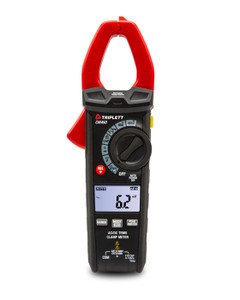Product description Style:AEMC 503 Clamp-Meter The AEMC 503 digital clamp-meter is an average-sensing, auto-ranging multimeter for measuring current, voltage, and resistance in electrical testing applications. It has a clamp that measures AC (alternating current) and DC (direct current) to 400A (amperes). The clamp has two jaws that can close around an electrical conductor up to 28mm (1.1 inches) in diameter to measure current without touching or interrupting the circuit. A set of test leads is included for measuring AC and DC voltage to 600V and resistance to 400 ohms. The meter has a rotary switch to select the property to measure, and a 4,000-count LCD that shows the reading numerically and in a 42-segment bar graph. To aid documentation of readings and capture readings in tight spaces, the data hold function keeps the most recent reading on the display after disconnecting from the circuit. A continuity buzzer confirms that the circuit conducts electricity. The unit operates on two AAA batteries, and turns off automatically after 30 minutes of non-use to conserve battery life. It has a low-battery indicator that signals when the battery needs to be replaced. This average-sensing, also called average responding or mean value, meter provides accurate readings when measuring linear loads, such as standard induction motors and incandescent lights, where the current or voltage has a sinusoidal waveform. It is auto-ranging, so it automatically selects the appropriate operating range for the property being measured. Accuracy and resolution specifications vary according to the range being measured. The meter meets EN (European Standard) safety standard 61010, and is rated for CAT (category) III installations to 300V, which covers equipment in fixed installations, such as switches in the fixed installation and some industrial equipment that is permanently connected to the fixed installation and CAT II installations to 600V, which covers energy-consuming equipment connected to a fixed installation, including household, office, and laboratory appliances. It has CE (European Conformity) marking. The unit comes with a soft carrying case. Specifications Maximum AC (alternating current) input 400A Maximum AC voltage input 600V Maximum DC (direct current) voltage input 600V Maximum frequency detected 400kHz Maximum resistance detected 400é Installation rating CAT III, 300V; CAT II, 600V Standards met EN safety standard 61010; CE marking Power supply (2) AAA batteries Weight 230g/8.11oz. Dimensions (H x W x D) 193 x 50 x 28mm/7.6 x 1.97 x 1.1 inches H is height, the vertical distance from lowest to highest point; W is width, the horizontal distance from left to right; D is depth, the horizontal distance from front to back. Clamp-meters, also called clamp-on meters, have two jaws that fit around a conductor to measure electrical current without cutting through wires, or touching or interrupting the electrical circuit. Available in handheld or benchtop models, clamp-meters diagnose problems in electrical equipment, wiring, and power supplies. All clamp-meters test for current. Some come with test leads and inputs for measuring voltage, capacitance, and resistance. They display information either in analog or digital form. Factors that influence meter choice include the electrical properties to be measured, the anticipated range of results, and the desired level of protection against transient voltage. Safety ratings are based on International Electrotechnical Commission (IEC) standards for low-voltage test equipment. IEC 61010 delineates four overvoltage installation categories. In general, a meter with a category IV rating will provide more protection against transient voltages than a meter with a lower category rating. AEMC Instruments manufactures electrical testing and measurement instruments, including clamp meters, power quality analyzers, ground resistance testers, and data loggers. The company, founded in 1893, is headquartered in Foxborough, MA. What's in the Box? AEMC 503 digital clamp-meter Test lead set (2) AAA batteries Soft carrying case Instructions
Got Question? Call Us 7:30am - 4pm CST: 713-904-4604
FREE SHIPPING ON ORDERS OVER $250 | APPLIES TO USA ORDERS ONLY | TERMS & CONDITIONS APPLY







